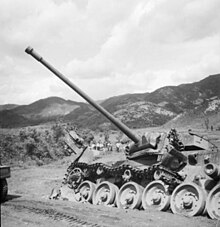Gloucester Hill
| Battle of the Imjin River | |||||||
|---|---|---|---|---|---|---|---|
| Part of the Korean War | |||||||
 Centurion tanks of the 8th Hussars disabled during the retreat of 29th Brigade on 25 April |
|||||||
|
|||||||
| Belligerents | |||||||
|
|
|||||||
| Commanders and leaders | |||||||
|
|
|
||||||
| Units involved | |||||||
|
|
|||||||
| Casualties and losses | |||||||
| 15,000+ (estimated) | |||||||
The Battle of the Imjin River, also known as the Battle of Solma-ri (Korean: 설마리 전투) or Battle of Gloster Hill (글로스터 고지 전투) in South Korea, or as Battle of Xuemali (Chinese: 雪马里战斗; pinyin: Xuě Mǎ Lǐ Zhàn Dòu) in China, took place 22–25 April 1951 during the Korean War. Troops from the Chinese People's Volunteer Army attacked United Nations (UN) positions on the lower Imjin River in an attempt to achieve a breakthrough and recapture the South Korean capital Seoul. The attack was part of the Chinese Fifth Phase Campaign, also known as the Chinese Spring Offensive, the aim of which was to regain the initiative on the battlefield after a successful UN counter-offensive in March 1951 had allowed UN forces to establish themselves beyond the 38th parallel at Line Kansas.
...
Wikipedia
